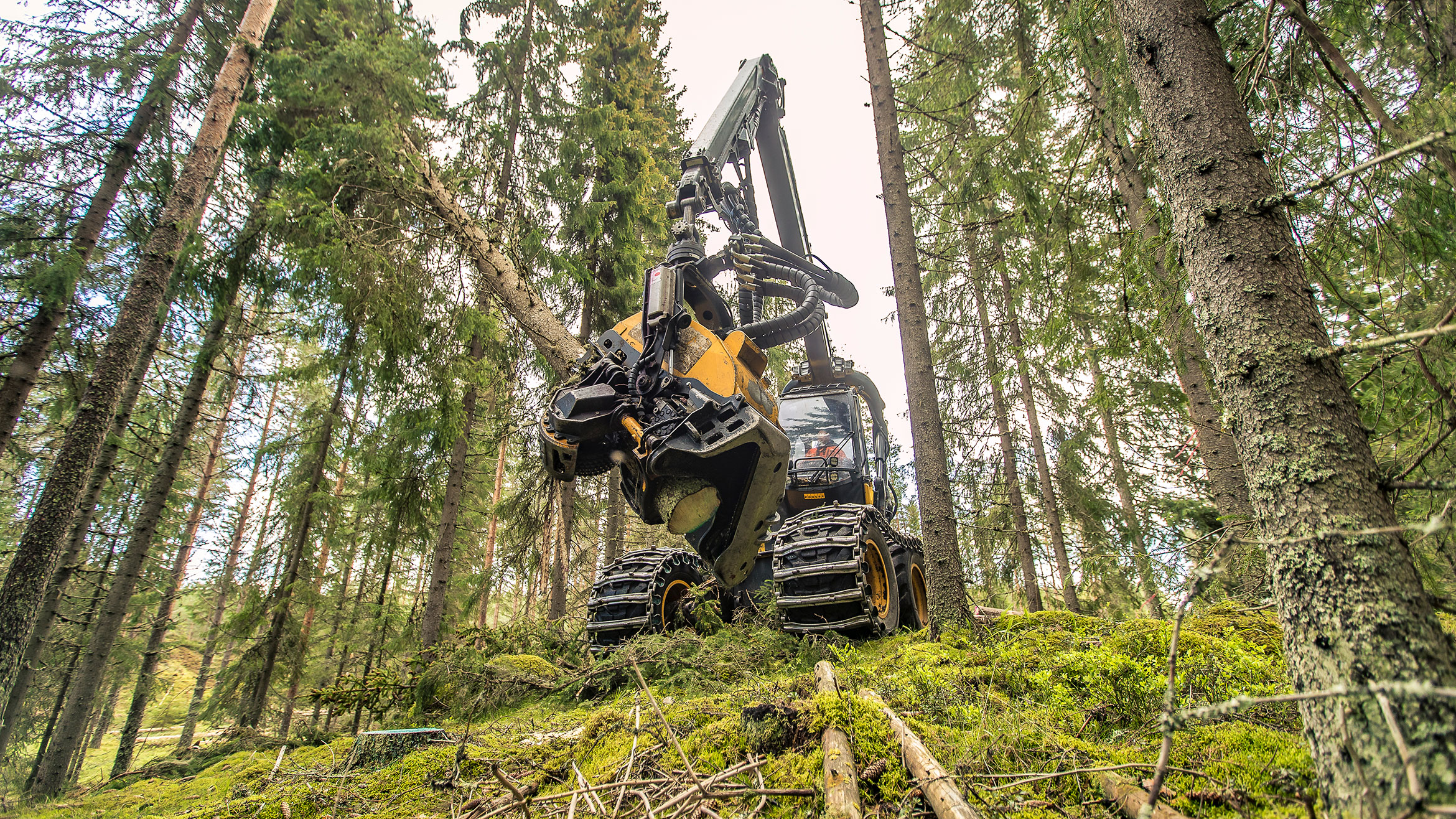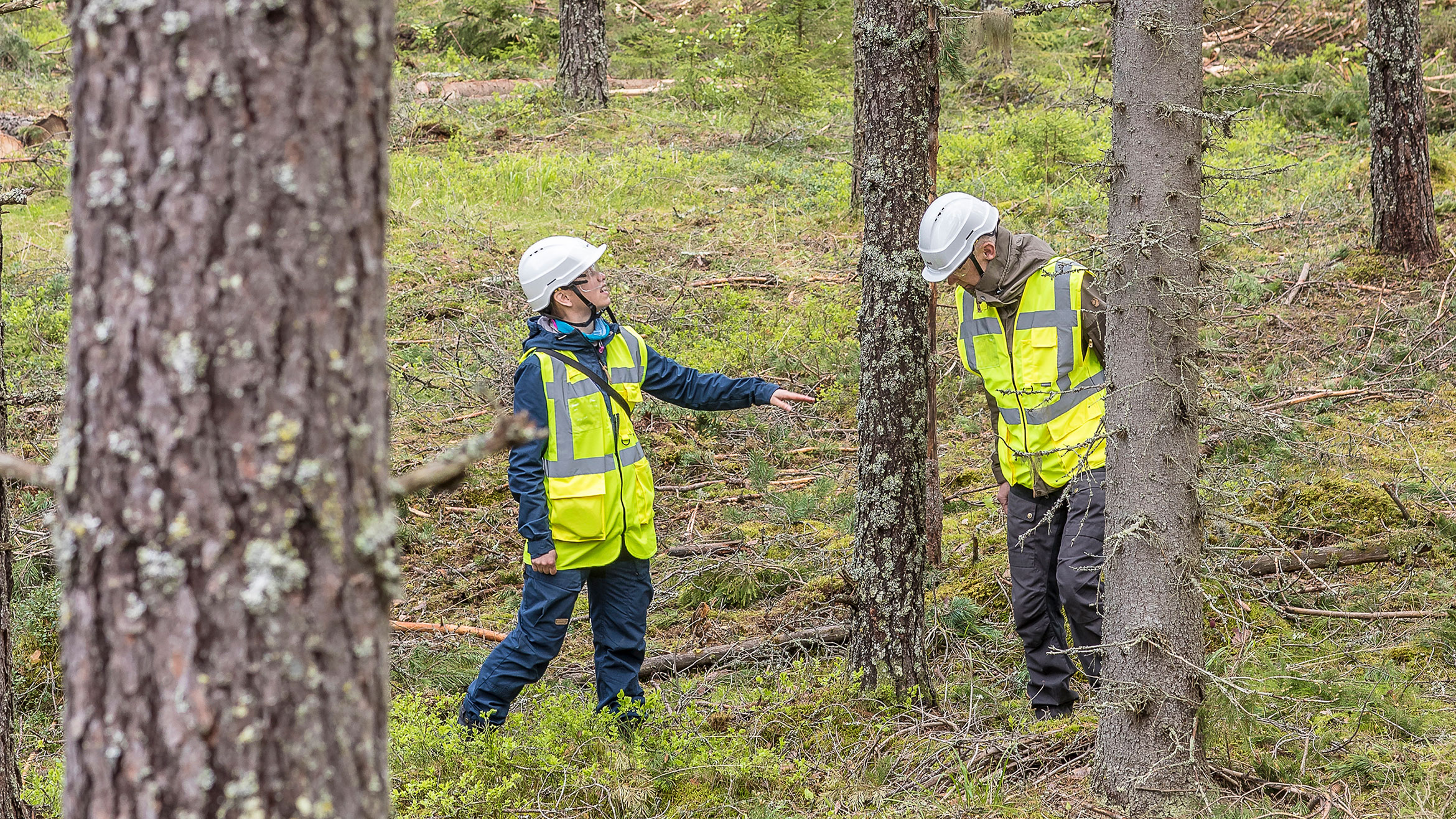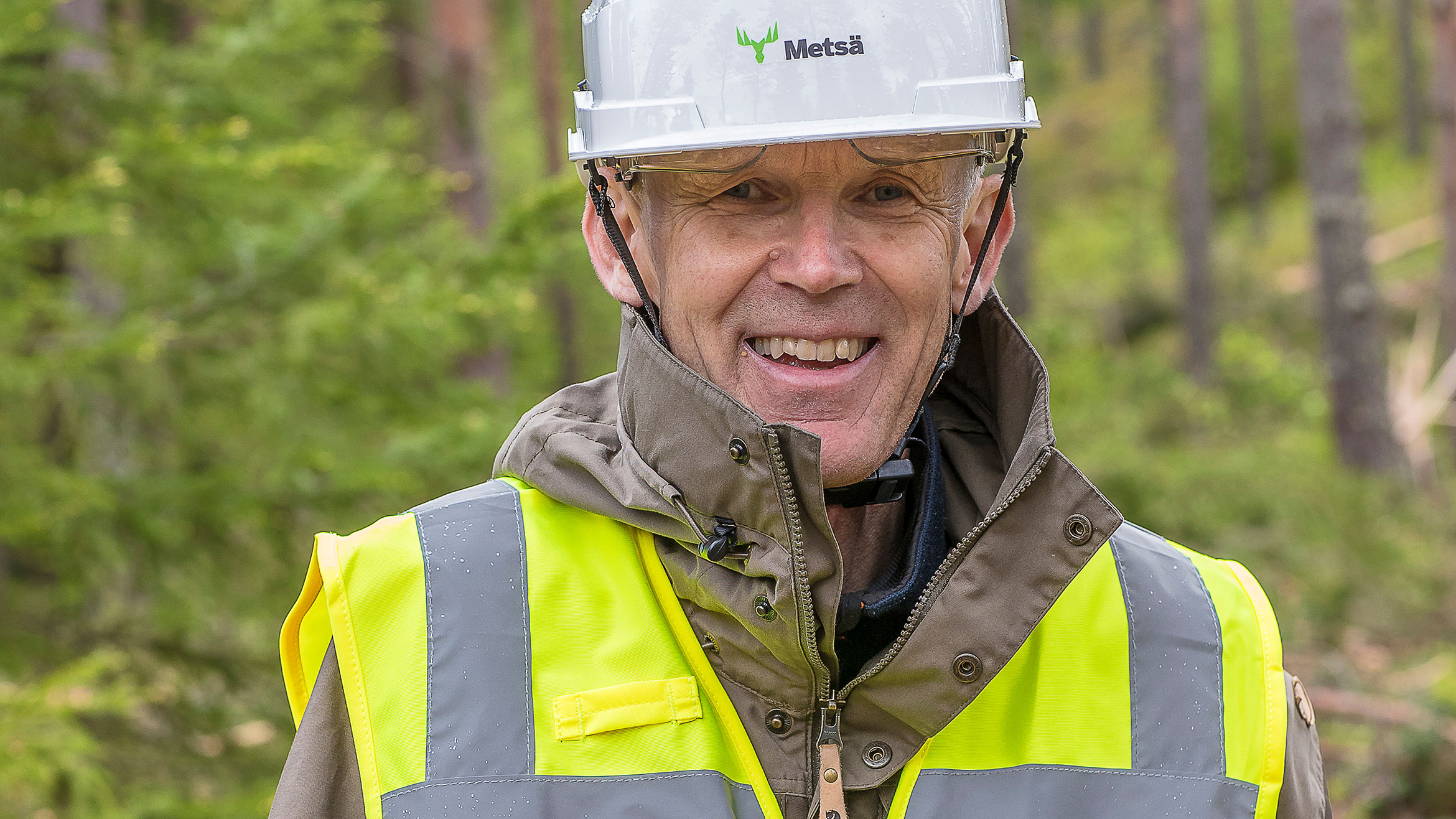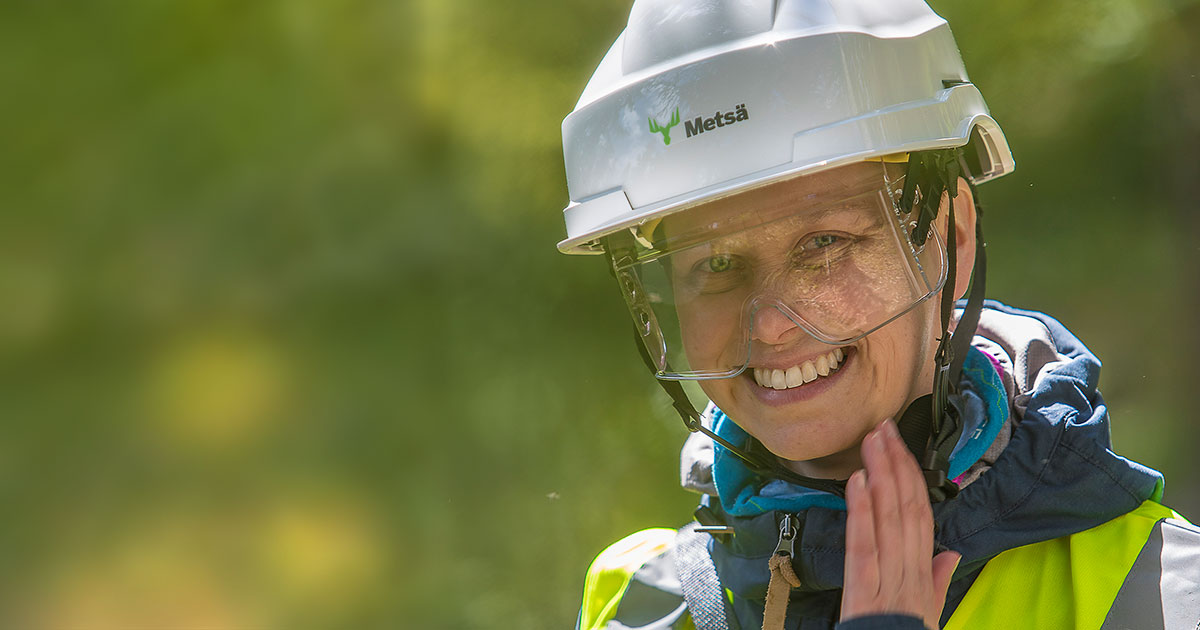Forest owner Antti Pätilä and Forest Specialist Anu Rautiainen from Metsä Forest watch closely as a forest machine fells and cuts spruce, pine and birch trees in Ruokolahti in South Karelia, 30 kilometres from the eastern border of Finland.
The teamwork between an efficient machine and a skilled operator makes for smooth progress in Pätilä’s forest.
Watching the operator’s manoeuvres, it is easy to see why forest machine operators are often compared to fighter pilots: both jobs require the ability to make constant, quick decisions. By some estimates, forest machines need to receive more than 4,000 commands an hour.
A forest machine is the world’s best workplace
Forestry Machine Contractor Janne Mutikainen is on shift in the cab.
Mutikainen’s quick and steady work leaves no doubt that he was quite literally destined to become a forest machine operator.
He was only two when he took his first ride in a forest machine. At the age of 15, he began weekend shifts in the harvesting company that his father had set up.
“This is the best job in the world. The work is varied, and every day is different. I get to work at my own pace and see the results right away. It is a great feeling when the forest owner visits you at the felling site and thanks you for a job well done.”
Mutikainen also has an ace up his sleeve: in addition to his forestry work, he is a trained electrotechnician. This helps with the modern harvester, which depends on electronic systems and electrically guided hydraulics.
The Ponsse Scorpion harvester that hums along under Mutikainen on eight massive wheels contains more than 2.6 km of electric wiring.
Wood is traced with identification numbers
Electronic systems also play a key role in the management of sustainable wood supply, says Anu Rautiainen.
She recorded the work instructions for the felling site being harvested by Mutikainen in the cloud service used by Metsä Group. Mutikainen and the other machine operators can see the instructions on the electronic map and its attachments, displayed on the screen of their machine.
Part of the instructions is a unique contract number, generated for each felling site. This number is the key for tracing wood batches as far as the mill gate. It identifies the owner of the forest supplying the wood to the mill.
“The number is visible to the forest machine operator and the timber lorry drivers. In the forest, the wood stacks are marked with confirmation slips showing the same number. This allows the timber lorry driver who picks up the wood to make sure that the identification numbers in the information system and on the slip are the same.”
Continuous information systems minimise human error. For instance, machine operators must mark each page of the digital work instructions as read before they can start felling.
“This is to confirm that the operator has not missed any instructions,” says Mutikainen.
He demonstrates on the computer screen how the exact location of the forest machine is charted on the digital map as the machine moves. The map shows the boundaries of the felling site, the machine tracks and even the locations of individual felled trees as small dots.
In addition to the accurate digital map, the flagging tape tied around the boundary trees of the felling site ensure that the neighbour’s trees are not taken.

Metsä Group’s wood buyer knows the seller
The forest specialist’s job is to help forest owners plan forest management and sales of wood. For many local forest owners, Anu Rautiainen is the face of Metsä Group and the first point of customer service.
In her customer register, Rautiainen has a group of forest owners with whom she is in contact at least annually. In the spring, she meets forest owners daily. In the winter, she spends two or three days per week in the forest.
“We discuss current forestry affairs, and I listen to their ideas or requests. I use these to make suggestions for forest management and felling.”
She says that working in the calm and peaceful environment of Eastern Finland has its advantages. People know one another better than they do in big cities.
“We quickly get to know the forest owners who sell wood to us, as well as their forests and, most importantly, what they want to achieve.”
Although Rautiainen buys wood from forest owners she knows, she always makes sure that the seller is entitled to sell the trees on offer, in accordance with Metsä Group’s policy.
First, she checks the public Land Information System for the owner of the forest plot where the wood on offer originates. Next, the identity of the seller is verified by the same methods that officials use to identify citizens.
“We ensure that the seller really owns the trees being offered.”
A forest specialist and digital services assist forest owner
Rautiainen knows Antti Pätilä. He inherited a forest from his parents and has since obtained more forest land. He has been an active forest owner for more than 50 years.
Although Pätilä has long forestry experience of his own, he appreciates the specialist’s view on what to do in the forest and when is the best time to do it. He and Rautiainen visit his forests once or twice a year, walking around and considering management needs and a felling schedule.
“Sometimes I initiate the conversation, sometimes it is Anu. We have a good, close partnership and I feel I get good service as a forest owner,” says Pätilä.
The forest owner also appreciates the electronic services for forest holding management, which have developed by leaps and bounds in recent years. His most important tool for browsing the information available is a digital and map-based management and felling plan for his forests. When he is out in the forest, Pätilä uses the plan on his phone.
He uses two different web services to manage his forests: Metsäverkko, a web service offered to forest owners by Metsä Group, and the free service Metsään.fi offered to all forest owners by the State of Finland. Metsään.fi is used by more than 100,000 Finnish forest owners.
“Web services are really great tools for a forest owner. You can handle almost everything with electronic systems today.”
Even the map system is 100 per cent reliable, says Pätilä.
“It gives me my own location in the terrain and is so accurate that I can find the boundaries of the estate and the fixed landmarks in the terrain on my phone screen. It is impossible to accidentally make a felling plan on the neighbour’s land.”
Forest Act defines how forests are used
When a forest owner wants to sell and harvest wood from their forest, they must file a forest use declaration with the authorities. The authorities check the declaration to ensure that the felling will take place in an area where it is allowed.
The declaration is an important part of Metsä Group’s information guidance system. Only after the forest use declaration has been issued and permission for felling obtained from the authorities does the system allow the forest specialist to send felling instructions to the machine entrepreneur.
The forest use declaration is part of Finland’s strong Forest Act, which defines how Finnish forests are used. Together with forest certification, which combines international and domestic requirements for sustainable forest management, the Forest Act sets a framework for forest management decisions by the owner.
“Ultimately, the forest owner makes the decisions, but the law or forest certification guidance cannot be ignored,” says Rautiainen.
Vesa Junnikkala, Director of Sustainability for Metsä Group, underlines the importance of market-based and voluntary certification systems. With these systems, the industry can demonstrate the origin of the wood it uses and that it originates in sustainably managed forests.
Metsä Group uses a chain of custody based on two different certification systems, FSC® and PEFC™, which can be used to trace the logistics chain of wood from the forest to the end product. The essential element of these systems is that an external third party ensures that the operation is run as promised.
“The market expects these things. We could not operate as a player of our size without a chain of custody certificate,” says Junnikkala.
Finns take good care of the family forest
Striding quickly through the mossy forest, forest owner Antti Pätilä stops to talk about the origin of wood. Having toured the world during his career, he knows full well that the markets need information.
This forest has been handed down from generation to generation and is very familiar to him. He has wandered, picked berries and hunted there since his childhood. This is also why he has such a strong emotional connection to it.
As a forest owner, he tells what he would say about the Finnish forest industry to customers and how he provides wood for industry and the markets.
He would give guests a tour of his forest, pointing out trees and citing the year in which he planted them or explaining how long ago he thinned a young stand that has now know grown into big trees.
“Forest ownership and wood production are like vegetable gardening. Through good management, you can increase the yield and everyone benefits.”
This article was originally published in Fibre and Timber Magazine issues 2021–2022.



